You and your sales team are out there working, talking with prospects, and closing deals—but if you aren’t closing enough sales to sustain the business, it’s time to try some new and additional B2B sales techniques to supercharge your numbers.
The only problem is, when you search Google for fresh ideas and sales techniques, you get a bunch of basic lists telling you beginner-level tactics are the answer to all your problems. But basic sales techniques aren’t what you need.
Most likely, you:
Already use them or
Tried them and they didn’t work for you.
Instead of sharing the same regurgitated sales tactics, we talked with our own experienced Sales Manager, Dipak Vadera.
Background
Dipak let us in on some of the more advanced B2B sales techniques he uses here at Leadfeeder—and they’re far from basic. In this article, we’re sharing 19 of those B2B sales techniques (including how he uses our own tool) that can take your sales team to the next level.
Note: Want to pull more leads out of your website visits? Sign up for a free 14-day trial of Leadfeeder to get insight into the companies that visit your website—even if they never fill out a form.
19 Next Level Ways to Find More Leads and Close More Sales
1. Frame Sales Conversations Around Behavioral Data
If you’re still going into sales conversations blind or armed with information you think prospects care about, you aren’t as effective as you could be. Instead, Dipak—our resident sales expert—uses Leadfeeder’s own behavioral data to ensure every sales conversation frames exactly what prospects are looking for.
For example, if he sees that a new lead looked at our Salesforce integration page, he uses that information to frame the conversation around integrating Leadfeeder with Salesforce.
Here’s another example: In the screenshot below, we can learn that this lead is interested in how GDPR applies to Leadfeeder and the website visitors we identify.
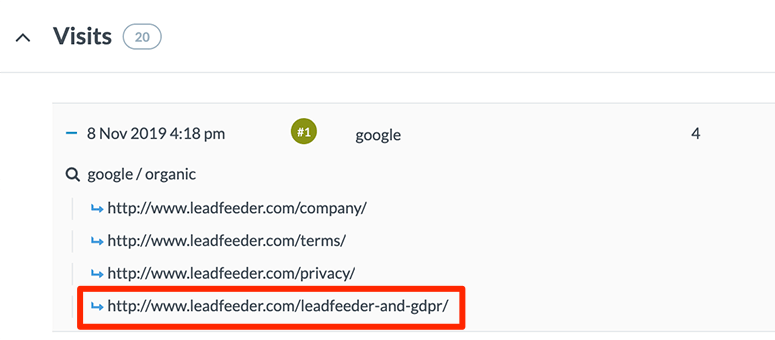
Armed with this knowledge, you and your team can ensure you include information about GDPR in your sales conversations.
2. Repurpose Marketing Content for Sales
If your company’s marketing team spends the time and effort to create great content, why not repurpose it to help you educate prospects and close more deals? That’s one of the sales techniques Dipak uses frequently—particularly on LinkedIn.
Repurposing content as sales collateral:
Extends the life of that content
Keeps the company’s messaging consistent
Here’s an example post:
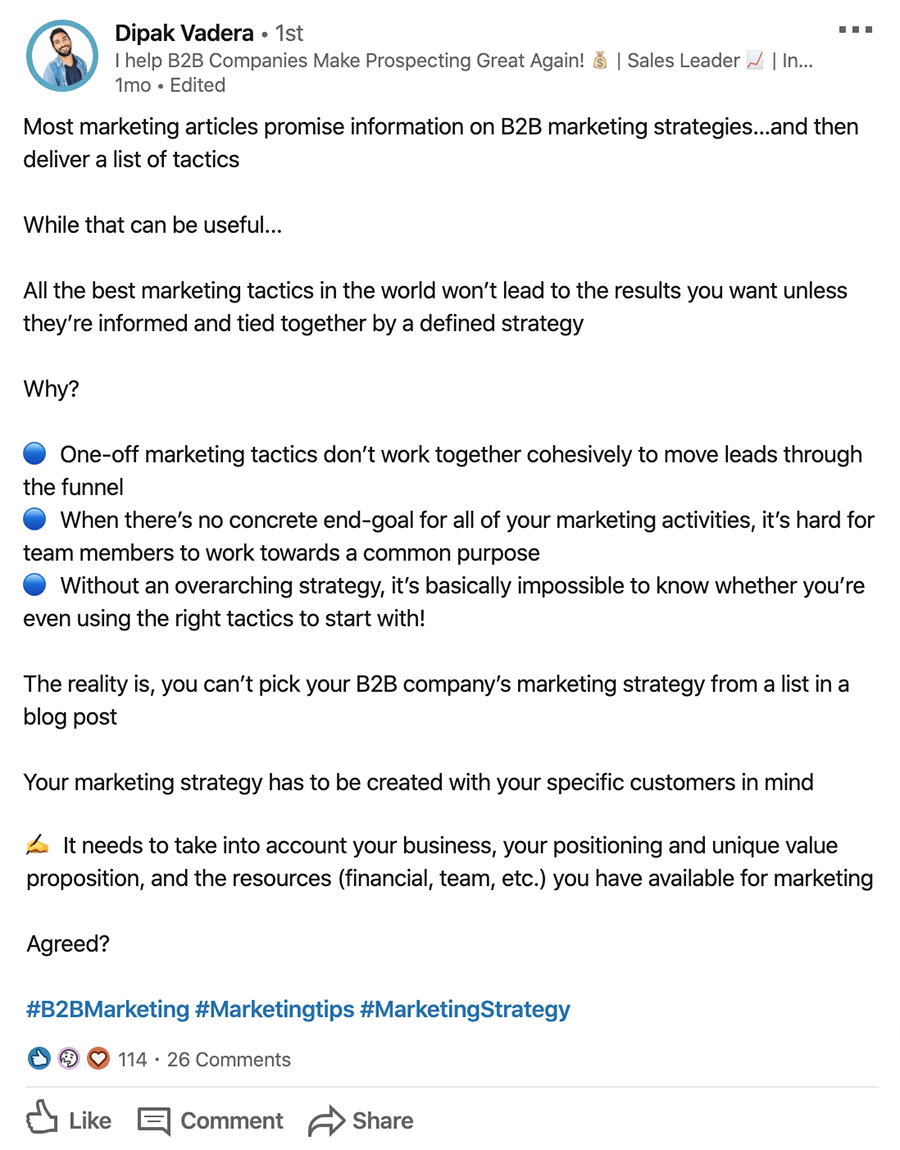
In it, Dipak repurposes content from our article on B2B Marketing Strategies to help build his authority and stir up conversation among prospects (without devoting precious time to creating additional original content).
Pro tip: Break longer-form content into bite-sized chunks to make it more accessible in the sales context and repurpose it into multiple posts.
3. Virtually “Attend” Industry Events
It’s no secret that, when you choose the right ones, attending industry events can lead to a lot of high-quality leads and exposure—but there’s only so many events you and your team can attend in person. To get around that harsh reality, Dipak “virtually attends” industry events.
In effect, he monitors hashtags, related experts, and influencers in his industry. He finds events to “attend” through those sources. Then, he takes part in the digital conversation surrounding those events. He chimes in on conversations, virtually follows along with speakers, and interacts with prospects who are physically at the event.
In that way, Dipak is able to make more connections and bring in new potential leads—without leaving his own city.
4. Build Your Personal Brand as an Authority
While there are a lot of B2B sales techniques you can deploy at the account and conversation level, there are also broader techniques that can boost sales. Among that set of sales techniques is the core tenet of social selling: building up your personal brand as an authority.
When your audience views you as an authority, it opens up all kinds of doors leading to potential sales. For example, you may connect with a decision-maker at the very tippy-top of the funnel—but if they see you as the expert on their problem, you already have a way to connect and explain your product as the solution.
5. Share Lead Magnets on Social Media
Building a personal brand on social media also helps supercharge this technique: posting lead magnets on social.
Lead magnets can bring in qualified, high-intent leads—but if you think they’re firmly in marketing’s realm, you could be missing out on your own network. In addition to how marketing uses lead magnets, Dipak also crafts compelling social media posts and offers to share lead magnets on his own personal social media accounts.
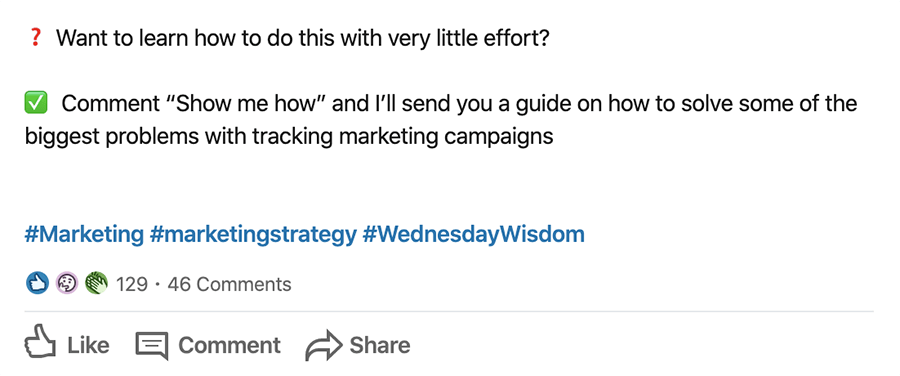
His number one tip for getting prospects interested is to follow the Problem → Solution → Call-to-Action (CTA) format with your post.
6. Use Competitor Keywords to Tap into Their Audience
At some point in every company’s growth cycle, you hit a point where you’re squeezing all the leads possible out of your own, existing audience. But if you still need more leads than that, it might be time to tap into your competitors’ audience.
Dipak suggests looking at the keywords your competitors use—in their sales messaging, in their search keyword targeting, and more. By understanding how competitors and their audience talk about themselves and their product, you can find more conversations online and more places to engage potential leads about your own product.
7. Turn Other Brands’ PR Distress into a Sales Opportunity
During our conversation, Dipak told us a story about one B2B sales technique he used in a prior role—capitalizing on another brand’s PR distress. When Dipak saw a prominent brand suffering through a crisis his company’s product could have solved (or at least mitigated), he turned their story into his sales pitch.
By taking the “don’t be like brand X” approach, Dipak was able to craft a more compelling and visceral argument for the product he was selling at the time.
8. Use Scheduling Tools to Send Emails at the Right Time
In the marketing world, testing is the holy grail of email marketing. Marketers spend countless hours testing, iterating, and automating email sequences to produce the results they’re looking for. But that’s a technique few salespeople really use.
Here’s an example: While testing the best time to send sales emails, Dipak found something counterintuitive—the highest open rates for C-suite level executives actually came from emails sent on Sunday.
The gist is that you don’t know what works best for your audience until you test. And what works best to reach your audience may not always be what’s most convenient for you or your team. That’s where email scheduling tools can come in handy, sending emails at the most optimal time—even if you aren’t at your desk.
9. Adopt Your Approach to Your Audience
In a similar vein, Dipak talked up how important it is to tailor your sales approach to your audience—not yourself.
For example: In a prior role, Dipak sold primarily to businesses in the Middle East. Unlike many other regions, they begin their workweek on Sundays. Once Dipak knew that, he could adopt his approach and his schedule to align with his prospects.
Another way to adopt your style to your audience is to use Crystal, “the app that tells you anyone’s personality.” Dipak uses this tool to help target his conversations to a prospect’s own tendencies and preferences.
10. Throw Out the Call Script
There’s definitely some value to sales call scripts—for beginner sales reps. But, as Dipak recommends, the better approach is to throw out the call scripts and canned responses.
Instead, he suggests outlining a basic structure or agenda for the call and training salespeople to adapt on the fly. As those reps grow to learn the product, use cases, and common objections, they’ll be better suited to connect with prospects on a human level, instead of falling back on pre-written responses (which pretty much always come across as canned).
11. Pull Leadfeeder Data into Your CRM
If you’re sensing a trend among these B2B sales techniques, it’s probably this: Finding more leads and closing more sales comes down to understanding your prospects better and using that information to craft a more relevant, compelling sales pitch.
With Leadfeeder, you can identify more website visitors and leads—and you can find a lot of information about them and their interests. To take that approach to the next level, Dipak suggests using our CRM integrations to push your Leadfeeder data into your CRM of choice. From there, you can use another tool (like Clearbit) to further enrich the information you have available about prospects.
12. Test Out Less Common B2B Sales Techniques
Once you get to a certain point in your sales career, you’ve probably at least tried most of the B2B sales techniques we commonly use today. That can make it feel like there’s nowhere left to go. When that happens, Dipak recommends testing out some of the less common or forgotten techniques.
For him, that’s direct mail. Even though it’s a tactic of old, new research shows that direct mail has gotten more effective as it becomes more of a novelty.
But, Dipak explained, direct mail is just an example here. There are tons of less popular sales techniques (some of them on this list) that might work for your business. If you’re feeling at a loss for how to generate or close more leads, they’re worth testing out.
13. Personalize Your Objection Handling
This sales technique goes along with Dipak’s suggestion to throw out the call script. For most new sales reps, objection handling means spouting off memorized pitches designed to cut through the most common objections you hear from prospects.
But once you’ve racked up years of experience in sales, it’s time to take your objection handling to the next level—by personalizing it.
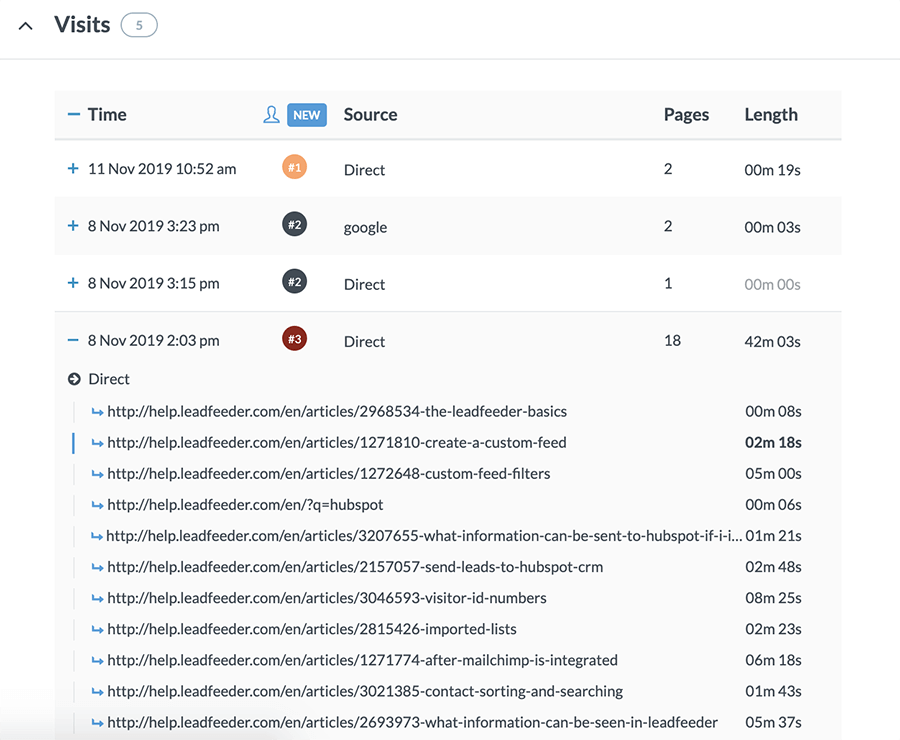
One way to add more personalization to how you handle objections is to use Leadfeeder data to get more context around the problem a prospect is facing, the solutions they may have considered, and other details.
14. Champion and Share Customer Success Stories
Whether your marketing team has a strategy around creating case studies and customer success stories or not, it’s always in your benefit to champion those stories and share them with other prospects. And these don’t have to be fancy, official “case studies” (although they certainly can be).
Maybe your product’s implementation is complicated or it can be used in a hundred different ways—the key to helping prospects understand how your product can help them is to show them how your product or service has helped other, similar businesses.
15. Work with Marketing to Get Better Leads from the Start
Many of the techniques we share here have to do with what happens after a company becomes a lead. Another way to close more sales is to bring in better leads from the start—and that involves working together with marketing.
As we’ve written previously, getting higher quality leads from marketing comes down to working with them to better define what makes a quality lead, a marketing qualified lead (MQL), a sales qualified lead (SQL), and so on. When marketing has a better sense of who is a good lead, they can work to find and send more of them your way.
16. Enrich Your Pitch with Social Proof
The more you can use the words and thoughts of actual customers, the more compelling your pitch will be, period. But case studies and customer success stories aren’t the only way to bring social proof into your sales pitch.
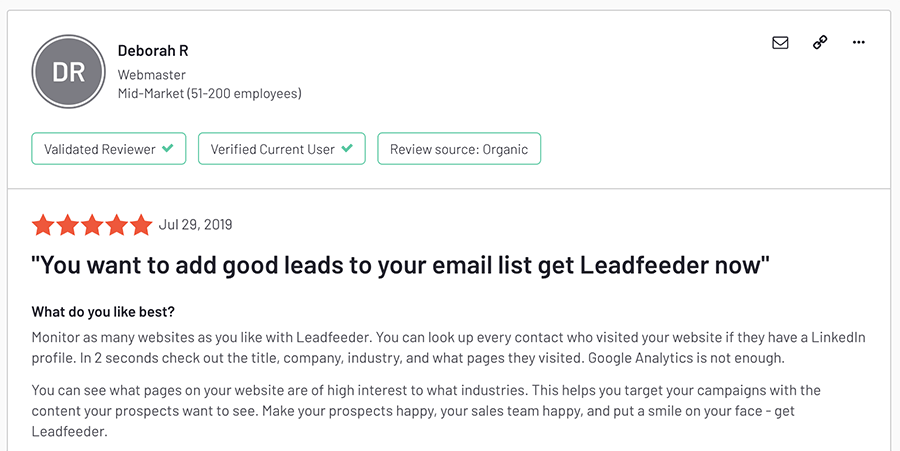
Instead, Dipak recommends casting a wider net—use customer reviews and ratings, social media posts, and customer feedback responses. Prospects will trust all of this information more than just about anything you say, making for a more trustworthy and compelling sales conversation.
17. Turn Your Website Visitors into Leads
The average B2B websites see around a 2% conversion. In other words, only about 2% of the people who visit your website will fill out a form or contact you in some way. If you need more leads, that other 98% of website visitors is a pretty good place to start.
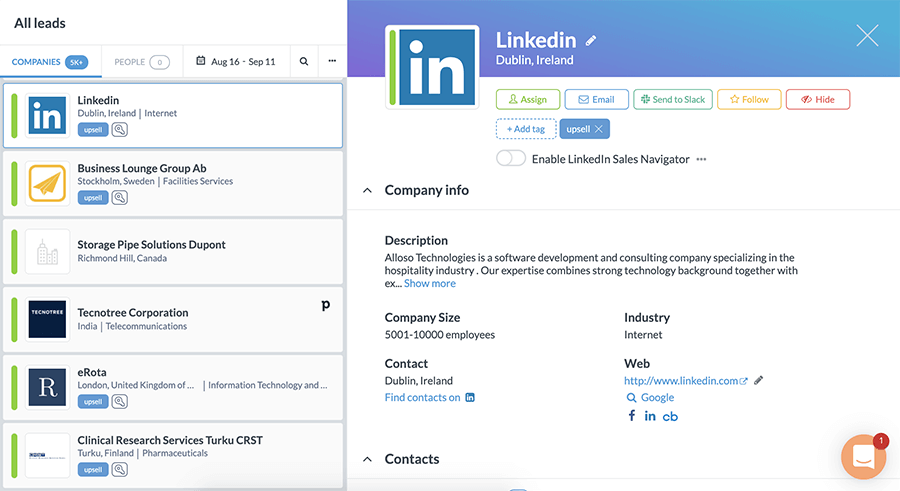
By using Leadfeeder, you can see the specific companies that visit your website—whether they converted or not. You can also see company details, behavioral visit data, and other information that helps to qualify and target your efforts toward the right leads.
Note: Want to see which companies visit your website, plus the pages they looked at, how long they stuck around for, and more? Sign up and try Leadfeeder free for 14 days.
18. Integrate Your Efforts with Marketing
Whether you’re selling big, enterprise deals or using account based sales, B2B selling typically involves longer and more complicated deal cycles. In situations like that, it’s imperative that sales and marketing work together, closely and cohesively, toward the same goals.
Everything from content tied to the buyer’s journey to email automation and B2B retargeting ads needs to work together with your sales efforts to move prospects toward a deal. The best way to ensure that happens is to work with marketing to map out an integrated buyer’s journey that details touchpoints on both sides.
19. Make Your Prospecting Strategy More Targeted
On the flipside of some of the sales techniques we’ve shared, closing more deals isn’t always about getting more leads into the funnel. Just as often, it’s more about getting fewer, better quality leads—and that means using a more targeted strategy for prospecting.
Instead of focusing on getting more and more leads into your pipeline, focus on getting the right leads. When you have fewer, more targeted leads to sell to, you can use a more tailored approach and messaging without worrying about how to scale your efforts.
B2B Sales Techniques for More Leads and Sales
When you need to close more deals—and feel like you’ve tried it all already—basic and generic sales techniques won’t do the trick. Instead, the next level B2B sales techniques our resident expert shared will help you find more leads and turn more of them into sales.
Now that you're here
Leadfeeder is a tool that shows you companies that visit your website. Leadfeeder generates new leads, offers insight on your customers and can help you increase your marketing ROI.
If you liked this blog post, you'll probably love Leadfeeder, too.
Sign up






